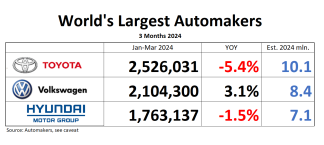When Chrysler Group LLC announced that it was withdrawing requests for Canadian Government aid earlier this week, my immediate reaction was to think: “there goes another piece of Canada’s auto industry.” Having just months ago watched GM close its Australian operations when it became clear the government there wouldn’t continue to subsidize the industry, it seemed clear that Chrysler would move at least one of its Canadian products to the waiting Toluca, Mexico plant. I was not alone in guessing that Windsor’s minivan plant would be on the block, but in its carefully-worded statement Chrysler indicated it would move ahead with the tool-up for a new generation of minivans there. Chrysler even committed to investing in “substantial product interventions” for Brampton’s Lx platform vehicles (300, Charger, Challenger), which are supposed to hit markets later this year.
So did FCA’s CEO Sergio Marchionne break the political math tying government support to new product investments? Not exactly. He still has plenty of room to maneuver, and lots of possible asks. And the likelihood that a Canada plant will end up losing a Chrysler plant to Mexico remains very high.
It’s not particularly difficult to understand Marchionne’s decision to stay the course in Canada while withdrawing requests for government money. Mired in political entanglements in the US and Italy, two countries whose cultures it trades on heavily in marketing, FCA hardly needs another nasty public battle over tax money. Moreover, FCA enjoys the number two market share in Canada, a ranking it enjoys in few other markets. Though Canada’s market is not large, Chrysler’s manufacturing footprint there gives its sales there an undeniable boost. Shutting down a plant in direct response to a government aid rejection could have triggered a bruising backlash, poisoning the FCA brand in a rare friendly market.
But avoiding a worst-case scenario is not the same as resolving underlying problems, and Chrysler’s lawyerly statement left the firm’s options wide open. While Chrysler “confirmed its intention to begin to allocate to our Windsor, Ontario plant the development and industrialization of the next [minivan] architecture,” Brampton’s Lx products were promised only a short-term refresh. Like General Motors, Chrysler signed a “vitality commitment” as a term of its Canadian government bailout which require it to maintain its manufacturing presence in the country through 2016. With only a short-term product commitment, Brampton seems as likely to close on or shortly after 2016 as GM’s Oshawa plant. That 1-2 punch would be devastating for Ontario, and carve the guts out of Detroit’s Canadian presence.
Unfortunately that scenario is highly likely. With Chrysler’s Toluca, Mexico plant unplanned past 2016, Marchionne has few reasons not to locate the next generation of Lx-derivative products there rather than Brampton. Mexico’s lower wages and trade advantages simply can’t be matched in Canada, and Chrysler probably can’t fill both Toluca and Brampton. Meanwhile, Canada is quickly becoming a political minefield for Chrysler, with challenges materializing across the political spectrum. On the right, Tim Hudak is scoring political points by campaigning against what he terms “corporate welfare” for the auto industry. On the left, the UNIFOR (formerly Canadian Auto Workers) is determined to battle the Two-Tier wage structure that the UAW has adopted. And in the middle, industry-friendly Canadian politicians seem baffled and hurt by the sudden breakdown of a once-cozy relationship.
And those problems aren’t going away: assuming Brampton does close after 2016, Chrysler’s Windsor plant will continue to produce minivans well into the future. With government money off the table, Marchionne called on “all stakeholders involved commit to do what they can to preserve the competitiveness of the country, and in particular of the province of Ontario,” a not-particularly subtle hint that the union will have to pick up the government’s slack. Chrysler will likely continue to push UNIFOR to accept Two-Tier wages at the next round of negotiation, but several obstacles stand in the way of change. First, Canadian labor leaders are likely to take a dim view of a company that was revived under part-ownership of the UAW forcing that union’s Two-Tier wage structure on Canadian workers. Second, Marchionne’s commitment to profoundly uncompetitive Italian labor undercuts his demands for Canadian labor concessions. Third, the fact that the Windsor investment is locked in removes Chrysler’s leverage in negotiations; once Windsor starts tooling up, Marchionne’s hands will be tied. Finally, the UAW’s recent loss at VW Chattanooga shows that Two-Tier wages effectively guts a union’s ability to bring new workers into the fold.
Under pressure from the UAW’s low entry wages as much as Mexico’s advantages, the stresses on Canada’s auto industry will continue to build as the impacts of the US auto bailout settle. In the short term, the future is fairly clear: Chrysler Brampton and GM Oshawa are likely to shut down. But how Canada responds to such a devastating loss, and whether politicians and unions will even try to head it off remains very much to be seen.






